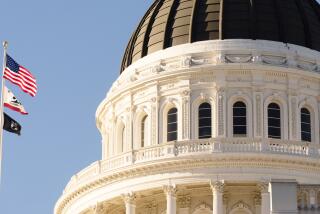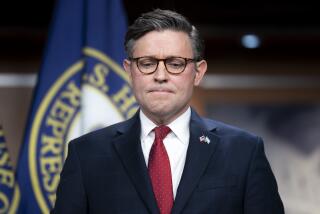S&P;: Polarization in D.C. risks another downgrade of U.S. credit
- Share via
WASHINGTON -- Standard & Poor’s warned Friday there is a 1-in-3 chance of a further downgrade of the U.S. credit rating by 2014 if Washington’s polarized political environment fails to produce a credible deficit reduction plan.
The AA+ long-term rating, a downgrade after last summer’s debt deal from the government’s previous rating of AAA, continues to carry a negative outlook, the ratings service said Friday.
“We think that recent shifts in the ideologies of the two major political parties in the U.S. could raise uncertainties about the government’s ability and willingness to sustain public finances consistently over the long term,” S&P wrote. “We believe that political polarization has increased in recent years.”
The agency said it wants to see a “medium-term” deficit reduction plan that is more substantial than the across-the-board budget cuts agreed to in last summer’s debt deal and scheduled to begin in January. Republican lawmakers in particular are now trying to undo those cuts – especially hits to the Pentagon.
S&P said another downgrade to the nation’s credit rating could be made if lawmakers are unable to agree to a more substantial plan.
“Pressure on the rating could build if, in our view, elected officials remain unable to agree on a credible, medium-term fiscal consolidation plan that represents significant (even if gradual) fiscal tightening beyond that envisaged,” the ratings agency said. “For such a plan to be credible, we believe it will require broad bipartisan support.”
S&P joined the advice from other nonpartisan analysts, who have warned Washington against making any sudden moves at the end of this year to raise taxes or cut spending as the economy continues to struggle. The nonpartisan Congressional Budget Office has said such action could throw the country back into a recession.
“We stress the qualifier ‘medium-term,’ ” S&P said, recognizing that “abrupt short-term measures could be self-defeating when domestic demand is weak.”
The nation’s debt load doubled during the George W. Bush administration, and then continued to climb under President Obama as tax revenues plummeted and spending increased to shore up the economy during the recession.
twitter.com/LisaMascaroinDC
More to Read
Get the L.A. Times Politics newsletter
Deeply reported insights into legislation, politics and policy from Sacramento, Washington and beyond. In your inbox twice per week.
You may occasionally receive promotional content from the Los Angeles Times.










